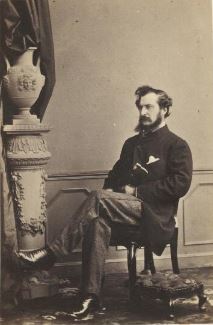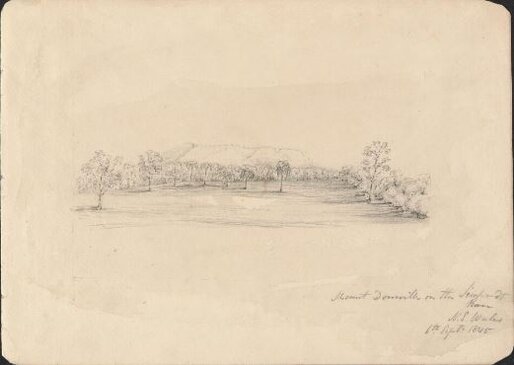Thomas John Domville Taylor (ca. 1817 – 1889) was one of the earliest settlers on the Darling Downs. While living and working in Queensland, Taylor made several sketches of the country around him, these being some of the earliest visual records of colonial life on the Downs.
Thomas John Domville Taylor was the third child of Mascie Domvile Taylor and his wife Diana née Houghton. He was baptised on 10 April 1817 in Chester Cathedral, his godfather being Lord Amesbury. Taylor’s father had matriculated from Brasenose College, Oxford in 1802 and attained a Master of Arts in 1809. He was appointed Rector of Langton, Yorkshire in 1818 and Moreton Corbett, Shropshire the following year, a post he held until his death on 9 October 1845. Macsie Domville Taylor held the Manorial seat of Lymm Hall; is it likely that Thomas and his siblings grew up there.
Taylor arrived in Sydney aboard the Euphrates on 20 December 1839. Little is known of his early time in Australia, however Taylor’s sketchbooks reveal that he travelled south to Omeo Plains and the Snowy Mountains before moving northward passing Liverpool Plains and Byron Plains, eventually reaching Queensland in 1841, accompanied by John Howell and Charles Markham. By 1842 Taylor had established himself with Dr John Rolland on a pastoral lease bordering the Condamine River known as the Broadwater. Rolland had travelled to the Downs with his wife Fanny and their two children in 1842. The lease for Broadwater had initially been taken up by James Wingate in 1841, but was renamed Tummaville by Rolland and Taylor by 1843.
As early arrivals in the region, Rolland and Taylor essentially built Tummaville from the ground up. Taylor’s sketch of the first camp at Tummaville shows a spartan set up of a circular tent and two gunyah-style constructions around a campfire, with a dray, a few head of cattle, chickens, a dog and a horse accompanying the party. A second sketch showing the finished station evidences that within a couple of years the business partners had erected four more substantial structures, including a large building with verandah and fireplace. Dr Rolland provided medical services to the community around him, and in October 1843 Fanny Rolland gave birth to the couple’s third child, Charlotte, the first baby to be born in the region.
The country that Tummaville occupied was known to Giabal, Gambuwal, Bigambul, and Jarowair communitites. As settlers expanded their occupation of the Darling Downs, tensions with indigenous communities disintegrated rapidly to the point of armed conflict. Taylor was personally connected to at least two conflicts, the first occurring in late 1842 when an aggressing party consisting of Ralph Gore, Sydenham Russell, and Taylor attacked an indigenous community who were passing through lands occupied by Tummaville and Yandilla stations. A second incident occurred in mid-1844, when reports emerged of hostile action by an indigenous group west of Ipswich. A dray belonging to the Forbes Brothers was halted and robbed; a short while later an attempt to rob a dray belonging to Rolland and Taylor passing the same route was unsuccessful. Taylor sketched another conflict in 1843 that may be connected to the storming of the Rosewood Scrub and the Battle of One Tree Hill. While it is uncertain whether Taylor was directly connected to this event, the presence of this sketch may indicate that Taylor was making an eyewitness account of the conflict.
In July 1844 Rolland and Taylor dissolved their business partnership. Taylor negotiated a new partnership for Tummaville with a member of the Ross family. This venture was short-lived; within a year Taylor left Tummaville to take part in an expedition mounted by Christopher Pemberton Hodgson to search for explorer Ludwig Leichhardt. A search party consisting of Hodgson, Taylor, James Rogers, Frederick Isaac, William Calvert, Peter Glynne (a servant of Pemberton Hodgson), and two indigenous guides, Bobby and Chinchimar (Johnny), was formed, and set out from nearby Jimbour Station on 8 August 1845. While on the expedition, Taylor kept a detailed expedition diary and took several sketches. After a six-week journey, the search party returned to Jimbour Station on 19 September 1845. Today the expedition diary and many of Taylor’s sketches are held in the National Library of Australia
Taylor’s father, Mascie Domvile Taylor died on 9 October 1845. It is perhaps for this reason that Taylor departed Australia for London on 16 June 1846 aboard the General Hewitt. Tummaville was acquired in 1846 by Thomas Gore, brother of St George Richard Gore who owned neighbouring station Yandilla. Thomas John Domville Taylor would not return to Australia. He died on 14 September 1889, at 7 Trouville Road, Clapham, England. He was survived by his wife Charlotte. His legacy in Queensland is noted in the localities of Tummaville, east of Millmerran; Domville, south of Millmerran; and Mount Domville (Meel Merran) south of Millmerran.
Citation
Timothy Roberts, ‘Thomas John Domville Taylor (ca. 1817 – 1889), Harry Gentle Resource Centre, Griffith University, 2020, https://harrygentle.griffith.edu.au/life-stories/thomas-john-domville-taylor/.
Archival Resources
Application to enter Moreton Bay Settlement
Letter from Domville Taylor to the Colonial Secretary, 4 January 1841, requesting access to Moreton Bay settlement.
Notice of payment of pasturage license
New South Wales Government Gazette, 27 October 1843 (no. 90), p. 1395.
Thomas John Domville Taylor, Journal of the expedition in search of Leichhardt, 1845 [Manuscript]. National Library of Australia, PIC MSR 14/1/6, Volume 1190.
Sketchbook by Thomas Domville Taylor, 1840-1848 National Library of Australia, Bib ID 7506247, PIC MSR 14/1/6, Volume 1190.
Sketchbook by Thomas Domville Taylor, 1840-1848 National Library of Australia, Bib ID 7506247, PIC MSR 14/1/6, Volume 1190.
Patty Ffoulkes scrapbook 1840-1844 [picture] / compiled by Patty Ffoulkes National Library of Australia, Bib ID 4970818, PIC, Volume 1126.
Books
Joseph Foster (ed.), Alumni Oxonienses: The members of the University of Oxford 1715-1886: their parentage, birthplace and year of birth, with a record of their degrees.
Oxford: Parker and Co., ca. 1891, p. 1395.
Biographical information for Mascie Domville-Taylor.
Christopher Pemberton Hodgson, Reminiscences of Australia: with hints on the squatter’s life.
London : W.N. Wright, 1846, pp. 343-345.
Recounting of the search expedition for Ludwig Leichhardt.
William Phillimore Watts (ed.), Shropshire Parish Registers: Diocese of Lichfield.
London: Shropshire Parish Register Society, 1900, Vol. 1, p. iv (between pp. 250-251).
Death record of Mascie Domville-Taylor.
Sydner: Turner & Henderson, 1888, p. 328.
Newspapers
Shipping Intelligence, Arrival, The Australian, 21 December 1839, p. 2.
News from the Interior, Moreton Bay, The Sydney Morning Herald, 9 August 1844, p. 4.
Advertising, The Sydney Morning Herald, 24 September 1844, p. 3.
Notice of Probate, Flintshire Observer, 21 September 1889, p. 6.







